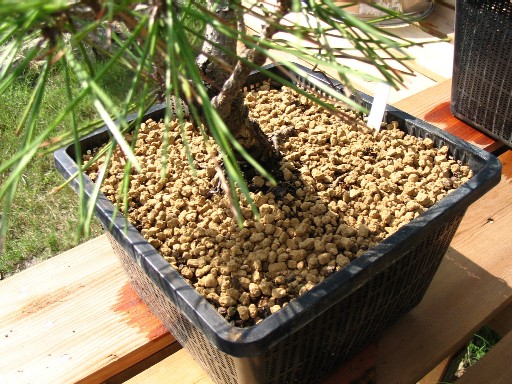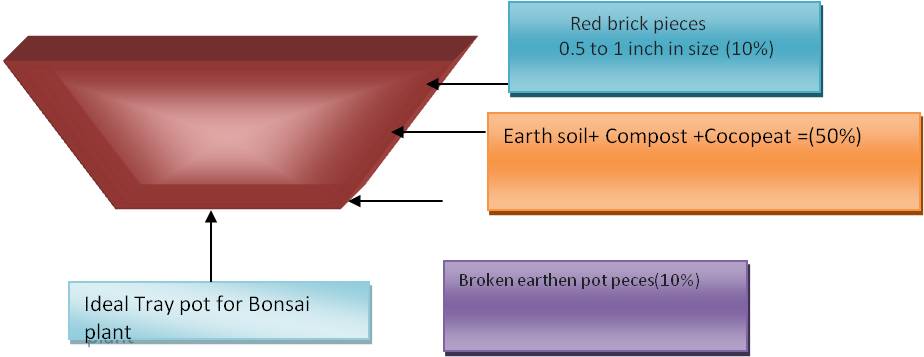
Soil for Bonsai, Every plant needs a medium to grow.
So like most other plants soil is a medium where plants grow. It’s the best medium for the bonsai plant also. A quarter of the soil decides the quality of growth of the plant. It’s good to understand basic preparation for soil.
There are lots of books and guides are available for this, but we discuss the material which available in our country.
So one must prepare the Bonsai soil mix India, mixture From the material available around us.
Table of Contents
What is an ideal mixture? [Bonsai soil mix India composition]
An ideal mixture that provides sufficient water, and nutrition in the form of minerals, and oxygen for roots.
It should be easily drained out soil mixture.
But it should retain some water to the requirements of the plant so it’s not getting dry while day time.
Also, be careful with water-logging it is very bad for fine root aeration and can down the plant.
Broken brick pieces can be used for brown-red soil which is not sticky and too fine in texture.
And river sand is useful for grey clay-like soil.
Brick and sand pieces are very good for small tender root formation.
The availability of small roots increases the plant’s capacity to acquire more oxygen, water, and nutrients.
Porous brick parts are good for moisture holding.
For a period of time to provide a good amount of nutrition good rotten cow dung manure or leaf-mold compost is helpful for bonsai plant growth.
Even good earth soil also provides strength to root soil.
A balanced soil mixture contains three materials garden soil, manure, and brick pieces. It is suitable for the majority of bonsai plants.
Soils you can use for – bonsai soil mix India composition
Akadama, Pumice, lava rock, Organic potting compost, and fine gravel are also known as grit.
All these contain together to make the best soil for the bonsai plant. This soil mixture is a bit different than other garden and pot mixtures like our regular soil.
Generally referred bonsai soil it’s a mixture of material like crushed lava rock. Which is look like gravel?
Akadama–

A type of soil especially produced for the bonsai plants. You can buy it online brought soil need to be shifted before use as it starts losing its compounding over a period from one year onward.
Or you may mix it well with well-drained soil to maintain aeration in the soil
Akadama is a hard premium soil mostly used by Japanese master gardeners for succulents and bonsai also.
It gets mined from volcanic soil in Japan.
Usually, it appears dark when watered and gets light in color when water gets off. So you can estimate the water requirements of the plant by it.
It’s the best soil that provides moisture retention & drainage at the same time.
This soil is also good for conifers, and succulents.
The good part about this soil is it’s highly porous in nature so holds nutrients and manages the overall drainage quality of the soil.
Akadama (akadamatsuchi, red ball earth). There are two types of it available. Surface mined and deep mined. Deep mined is more useful in horticulture than surface mining.
It can be mixed with other soil medium components like crushed lava, peat, and leaf biomass.
It’s unique for its characteristic so even though it’s costly it gets recommended by expert gardeners. It retains water, nutrients and has porosity, and also allows good drainage.
It originated in Japan, mostly due to volcanic activities n Japan. So they have developed two soils Akadama and Kanuma.
Its particle size is mostly around 2-6 mm and its fine particle size is 1-2.2 mm.
All size is good for potted plants but, a small size referred to as Shohin is good for cactus and succulents plants.
Usually, ready mix bonsai soil is available in the markets and online also. But it’s getting costlier and to make mixture your self is cheap and good for our plant’s requirement.
In the case of bonsai, poor soil mixtures lack the overall health of the plants, and soil types that get hard quickly and dry are harmful to Bonsai and other plants also.
The world Akadama is red for color and the ball is for its shape. This material comes from Volcanic clay from Japan. It’s. Get mined and then backed for desired hardiness hardness. Then sifted before use or sell.
The good and beneficial part is when Akadama used while planting roots need less water and as it gets regular watering particles breaks in smaller parts and old roots hold them and they need more water so this is how they solve the purpose for thick bonsai stem look through proper root growth with the help of the Akadama soil.
There are soil mixtures also available with Akadama in it.
Pumice

It’s an airy rock that is good to use for cacti & succulents, And for other plants also.
It is generally gets born from heavily heated earth. A bubbled volcanic rock material is what we call Pumice.
Pumice porosity let microbial life grow so it also maintains the soil structure. It has a neutral PH and bears some trace material also.
If mixed with sandy soil it increases soil absorption. It improves aeration and stimulates the growth of mycorrhiza.
How to use Pumice as a soil amendment?
Especially to improve drainage for heat tolerating plants such as succulents, and cactus you can mix 20% Pumice with 27% earth soil and 27% large grain sand & 27% compost (FYM). Is an ideal bonsai soil mix ratio of pumice.
You can use 40-50% pumice for plants like euphorbias which are prone to rotting.
It can be used as a top dressing to defend piddling rainwater around plants.
You can use 40-60% pumice with potting soil mix for cactus & euphorbia.
It does not break down. Heavy soil gets loosened by it. Improves aeration and stops compacting of the soil.
Bonsai soil mix India composition [bonsai soil making]
Usually, the Japanese method filters soil with different sieves to yield 7 grades of soil, but here we don’t require that much.
Firstly dry the soil mixture, and break lumps.
Sift through the sieve of two squares to 2.5cms
Then throw away stones which not pass through.
Then pass the mixture to the fine sieve of four meshes to 2.5cms
Keep material that is left in the sieve after the filter.
It’s a coarse mixture used at the bottom
The remainder will be once more sifted to a sieve of 32 meshes to 2.5cms, so fine dust will pass through this sieve.
This fine dust is not good for the plant it hardens the mixture and aeration to roots. And also disturbs the drainage.
Now the mixture that remained on top needs to pass through a sieve of 16 meshes to 2.5cms. The passed mixture is called topsoil.
Bonsai soil mixture proportions vary to different plant requirements.
We can manage the mixture if some plant needs dry soil you can add more brick pieces and sand to the mixture. If any plant requires good water retention then we can add soil and manure mixture to the soil mixture.
But we need to be a little bit vigilant for moisture checks as per plant requirements and its health.
How to make Bonsai soil mix India easily as a beginner
We are going to learn a very basic mixture of the available material around. And cost-effective so any beginner/ Newbie can start.
Below are the main bonsai soil ingredients/ bonsai soil mix ratio :
Earth soil/ Garden soil (50%)
Well, drained earth soil/garden soil. For better holding and nutrients supplements of the roots. This soil is a common part of all soil mixtures.

Gravel/ red brick particle (20%)
We can make it from materials like Gravel/ red brick particles, Earth soil, cocopeat, and FYM (compost)
Gravel /grit or Red brick particle sized from 0.3 inches to 0.8 inches. It provides good aeration to the root systems of the Bonsai Plant.
Cocopeat (15%)– this will you need in a little bit quantity but it’s just for the better water retention Because compared to other plants in regular deep pots bonsai plants’ soil gets dry soon in less deep tray planters. So cocopeat is best for moisture holding and if not available you can replace it with Sphagnum mass or Peat moss.
Compost (15%)
And last but not least Compost (FYM). It’s the best source of most of the nutrients required for the bonsai plant.
We aim to provide the most practical garden learning here hope you learn very well how to make bonsai soil mix in India.
Find it helpful don’t forget to share.. it is free 🙂
What is Akadama soil?
Akadama is a naturally occurring substance that means “red earth ball’. It exactly looks like clay in color. But actually, it’s not clay.
It’s get mined from volcanic surroundings in Japan.
After mining it gets dried then gets backed to the desired temperature and then sifted to different sized grades.
In general, you can refer to it as volcanic Pumice.
Can I mix Akadama with soil?
Depending upon plant species you can mix Akadama with growing material such as sand, peat and compost, and earth soil.
Is Akadama soil good?
It is useful both as per topping material as well as a soil medium for growth. And gets mixed with other materials like sand, peat, and compost to make growing material for Bonsai/Plants.
It has a good span of repotting. You need to replace it around 5-7 years later.
- Good for root growth
- Best for water retention
- Improves nutrients retention
- Good drainage ability
What can I use instead of Akadama?
After 2 to three-year Akadama start breaking down, so its results in less aeration. Then we need to re-pot. Hence we need to mix it with other well-draining soil components.
You can use kitty litter instead of Akadama or Pumice also. Or other soil mixture containing peat moss, coco peat, perlite, river sand, etc.
